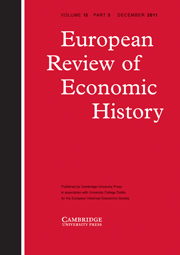Crossref Citations
This article has been cited by the following publications. This list is generated based on data provided by
Crossref.
Ajus, Ferenc
2010.
What caused fertility variations by settlement in Transylvania at the time of industrialization?.
The History of the Family,
Vol. 15,
Issue. 4,
p.
453.
Dribe, Martin
and
Scalone, Francesco
2010.
Detecting Deliberate Fertility Control in Pre-transitional Populations: Evidence from six German villages, 1766–1863.
European Journal of Population / Revue européenne de Démographie,
Vol. 26,
Issue. 4,
p.
411.
DRIBE, MARTIN
and
VAN DE PUTTE, BART
2012.
Marriage seasonality and the industrious revolution: southern Sweden, 1690–18951.
The Economic History Review,
Vol. 65,
Issue. 3,
p.
1123.
Stanfors, Maria
and
Scott, Kirk
2013.
Intergenerational transmission of young motherhood. Evidence from Sweden, 1986–2009.
The History of the Family,
Vol. 18,
Issue. 2,
p.
187.
Becker, Sascha O.
Cinnirella, Francesco
and
Woessmann, Ludger
2013.
Does women's education affect fertility? Evidence from pre-demographic transition Prussia.
European Review of Economic History,
Vol. 17,
Issue. 1,
p.
24.
Dribe, Martin
Hacker, J. David
and
Scalone, Francesco
2014.
The impact of socio-economic status on net fertility during the historical fertility decline: A comparative analysis of Canada, Iceland, Sweden, Norway, and the USA.
Population Studies,
Vol. 68,
Issue. 2,
p.
135.
Breschi, Marco
Fornasin, Alessio
Manfredini, Matteo
Pozzi, Lucia
Rettaroli, Rosella
and
Scalone, Francesco
2014.
Social and Economic Determinants of Reproductive Behavior Before the Fertility Decline. The Case of Six Italian Communities During the Nineteenth Century.
European Journal of Population,
Vol. 30,
Issue. 3,
p.
291.
Bengtsson, Tommy
and
Dribe, Martin
2014.
The historical fertility transition at the micro level.
Demographic Research,
Vol. 30,
Issue. ,
p.
493.
Dribe, Martin
and
Scalone, Francesco
2014.
Social class and net fertility before, during, and after the demographic transition: A micro-level analysis of Sweden 1880-1970.
Demographic Research,
Vol. 30,
Issue. ,
p.
429.
Ager, Philipp
Hansen, Casper Worm
and
Jensen, Peter S.
2014.
Fertility and Early-Life Mortality: Evidence from Smallpox Vaccination in Sweden.
SSRN Electronic Journal,
Dribe, Martin
Oris, Michel
and
Pozzi, Lucia
2014.
Socioeconomic status and fertility before, during, and after the demographic transition: An introduction.
Demographic Research,
Vol. 31,
Issue. ,
p.
161.
Bras, Hilde
2014.
Structural and diffusion effects in the Dutch fertility transition, 1870-1940 .
Demographic Research,
Vol. 30,
Issue. ,
p.
151.
Murphy, Tommy E.
2015.
Old habits die hard (sometimes).
Journal of Economic Growth,
Vol. 20,
Issue. 2,
p.
177.
Öberg, Stefan
2015.
Sibship size and height before, during, and after the fertility decline.
Demographic Research,
Vol. 32,
Issue. ,
p.
29.
Edvinsson, Rodney Benjamin
2015.
Recalculating Swedish pre-census demographic data: Was there acceleration in early modern population growth?.
Cliometrica,
Vol. 9,
Issue. 2,
p.
167.
Axelsson, Per
and
Wisselgren, Maria J.
2016.
Sweden in 1930 and the 1930 census.
The History of the Family,
Vol. 21,
Issue. 1,
p.
61.
MOLITORIS, JOSEPH
and
DRIBE, MARTIN
2016.
Ready to stop: socioeconomic status and the fertility transition in Stockholm, 1878–1926.
The Economic History Review,
Vol. 69,
Issue. 2,
p.
679.
Klüsener, Sebastian
Scalone, Francesco
and
Dribe, Martin
2017.
Agent-Based Modelling in Population Studies.
Vol. 41,
Issue. ,
p.
369.
Dribe, Martin
Breschi, Marco
Gagnon, Alain
Gauvreau, Danielle
Hanson, Heidi A.
Maloney, Thomas N.
Mazzoni, Stanislao
Molitoris, Joseph
Pozzi, Lucia
Smith, Ken R.
and
Vézina, Hélène
2017.
Socio-economic status and fertility decline: Insights from historical transitions in Europe and North America.
Population Studies,
Vol. 71,
Issue. 1,
p.
3.
Breschi, Marco
Esposito, Massimo
Fornasin, Alessio
and
Manfredini, Matteo
2017.
Reproductive Change in Transitional Italy: More Insights from the Italian Fertility Survey of 1961.
Annales de démographie historique,
Vol. n° 132,
Issue. 2,
p.
111.


